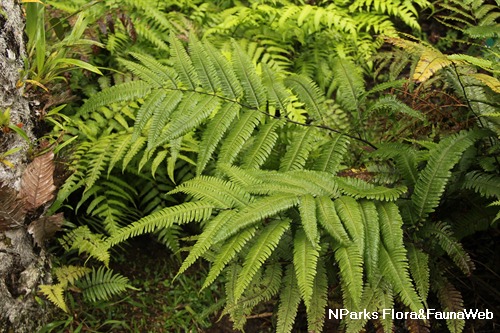
Back
Pteris ensiformis Burm.f.
| Family Name: | Pteridaceae |
| Common Name: | Sword Brake, Slender Brake, Paku Padang, 剑叶凤尾蕨 |
Name
Classifications and Characteristics
| Plant Division | Ferns & Lycophytes (Non-Seed Vascular Plants) (Fern) |
|---|---|
| Plant Growth Form | Herbaceous Plant |
| Mode of Nutrition | Autotrophic |
Biogeography
| Native Distribution | Tropical & Subtropical Asia to Pacific |
|---|---|
| Native Habitat | Terrestrial |
| Preferred Climate Zone | Tropical |
| Local Conservation Status | Cryptogenic |
Description and Ethnobotany
| Growth Form | Fern with a creeping slender rhizome, bearing fronds closely together, able to grow up to 20 - 40 cm tall. |
|---|---|
| Foliage | Fronds are dimorphic, fertile frond blade measuring up to 30 cm long and stipe measuring about 30 - 50 cm long, infertile frond blade measuring up to 15 cm long and stipe measuring about 5 - 15 cm long. |
| Reproductive Parts - non-flowering plant | Sori arranged linearly and submarginal, indusia is pale green in colour. |
| Etymology | Genus Pteris is from the Greek word "pteruc" which is the Greek name of a fern. Species ensiformis means having "sword-shaped" leaves. |
| Ethnobotanical Uses | Medicinal: A decoction of the fronds is used to treat dysentery. |
Landscaping Features
| Desirable Plant Features | Ornamental Foliage |
|---|---|
| Landscape Uses | Interiorscape/ Indoor Plant, Parks & Gardens, Small Gardens, Container Planting |
Fauna, Pollination and Dispersal
| Seed or Spore Dispersal | Abiotic |
|---|
Plant Care and Propagation
| Light Preference | Semi-Shade |
|---|---|
| Water Preference | Moderate Water |
| Plant Growth Rate | Fast to Moderate |
| Rootzone Tolerance | Moist Soils, Well-Drained Soils |
| Propagation Method | Spore, Division |
Foliar
| Foliage Retention | Evergreen |
|---|---|
| Mature Foliage Colour(s) | Green |
Image Repository
Others
| Master ID | 270 |
|---|---|
| Species ID | 1566 |
| Flora Disclaimer | The information in this website has been compiled from reliable sources, such as reference works on medicinal plants. It is not a substitute for medical advice or treatment and NParks does not purport to provide any medical advice. Readers should always consult his/her physician before using or consuming a plant for medicinal purposes. |


.jpg)

.jpg)